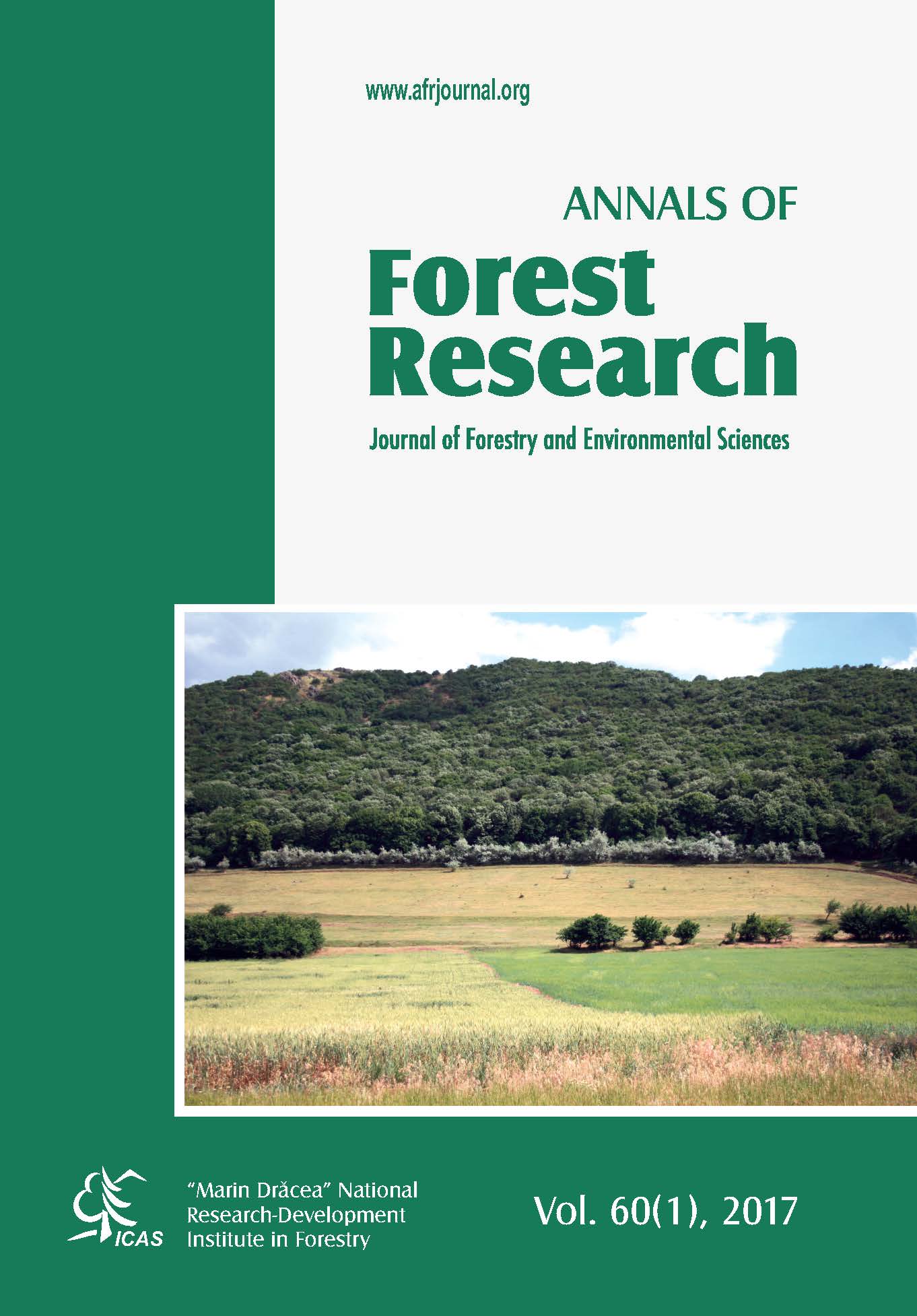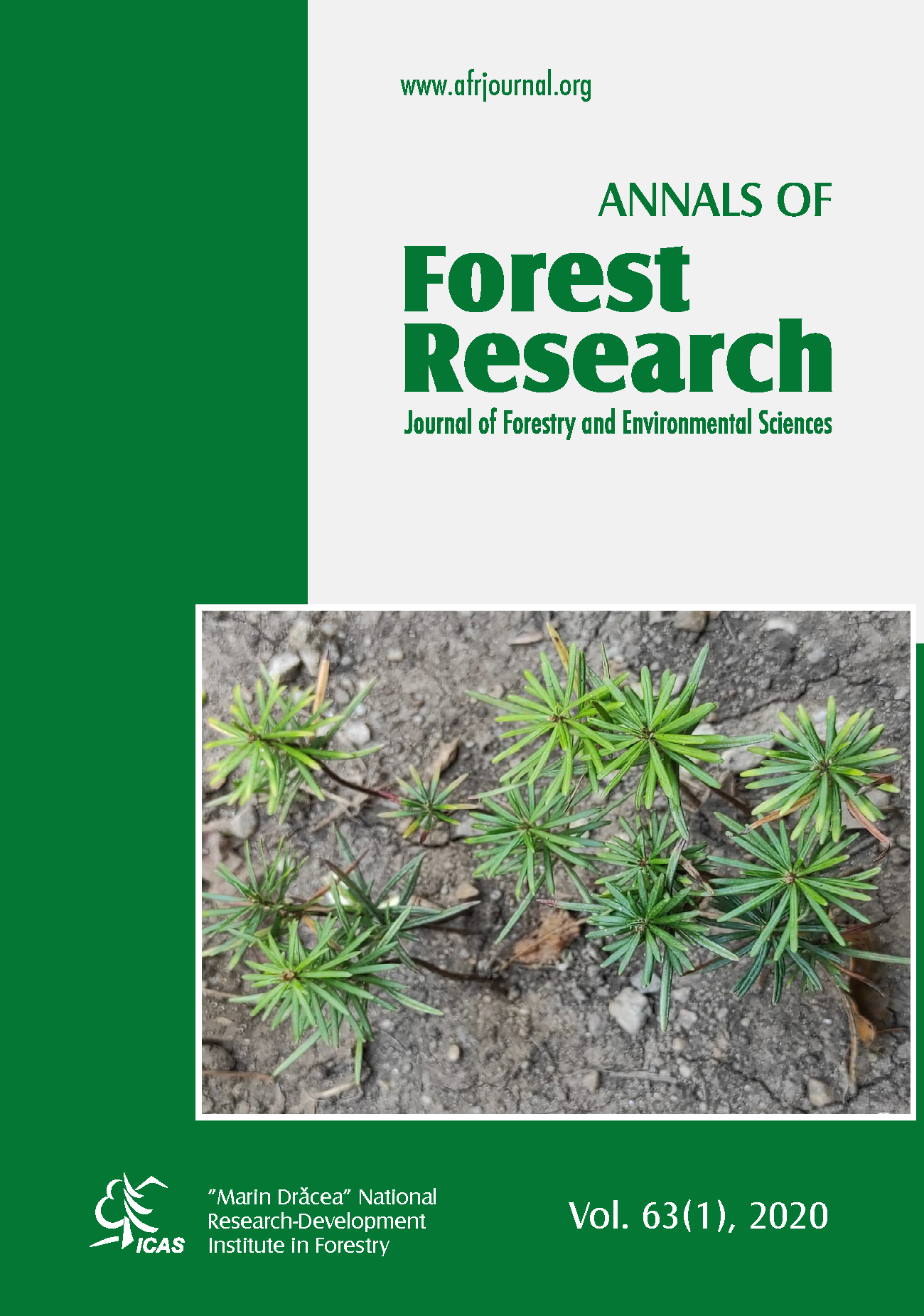Seasonal variability of interception and water wettability of common oak leaves
DOI:
https://doi.org/10.15287/afr.2016.706Keywords:
hydrophilicity, cuticle waxes, SEM, PCA, ecohydrology, PolandAbstract
Wettability of leaves and the resulting amount of interception loss of tree crowns is an important component of the atmosphere-tree stand-soil system balance. In the study, we hypothesized that changes occurring in leaves during the vegetation period can significantly affect the amount of rainwater retained by plants and wettability of leaves which is expressed by the contact angle between drops and leaves. We evaluated the hypothesis based on measurement series, which combined direct spraying of leaves with water at different stages of development at a constant temperature with observations made with an electron scanner which was used to determine changes occurring within a leaf, while the photographic method was used to analyze the contact angle of drops. The study involved common oak (Quercus robur). Samples of twigs derived from this species were collected in the area of Przedbórz (Poland) forest district, in particular from the trees with well-developed crowns. Twigs were collected from 10 trees of similar age (35–40 years). The resulting database contained experimental data on changes of raindrop adhesion on oak leaves throughout the growing season. The internal contact angle of drops was within the range of 150° on the upper side of the leaf and 160° on the underside in May, up to 15° and 35° in November on the upper and underside of the leaves. Loss of interception was established at 6% at the beginning of the growing season up to 22% in autumn. It was concluded that the wettability and the level of interception increases in line with the age of a leaf.
References
Adamec L., 2013. Foliar mineral nutrient uptake in carnivorous plants: what do we know and what should we know? Frontiers in Plant Science 4: 10. DOI: 10.3389/fpls.2013.00010
Aryal B., Neuner G., 2010. Leaf wettability decreases along an extreme altitudinal gradient. Oecologia 162: 1-9. DOI: 10.1007/s00442-009-1437-3
Aussenag G., 2000. Interaction between forest stands and microclimate: Ecophysiological aspects and consequences for silviculture. Annals of Forest Science 57: 287-301. DOI: 10.1051/forest:2000119
Barthlott W., Neinhuis C., 1997. Purity of the sacred lotus leaf, of escape from contamination in biological surfaces. Planta 202(1): 1-8. DOI: 10.1007/s004250050096
Berry Z.C., Hughes N.M., Smith W.K., 2013. Cloud immersion: an important water source for spruce and fir saplings in the southern Appalachian Mountains. Oecologia 173(3): 637-648. DOI: 10.1007/s00442-013-2653-4
Berry Z.C., Hughes N.M., Smith W.K., 2014. Cloud immersion: an important water source for spruce and fir saplings in the southern Appalachian Mountains. Oecologia 174 (2): 319-326. DOI: 10.1007/s00442-013-2770-0
Bhushan B., Jung Y.C., 2006. Micro- and nanoscale characterization of hydrophobic and hydrophilic leaf surfaces. Nanotechnology 17(11): 2758- 2772. DOI: 10.1088/0957-4484/17/11/008
Burkhardt J., Hunsche M., 2013. Breath figures on leaf surfaces – formation and effects of microscopic leaf wetness. Frontiers in Plant Science 4: 422. DOI: 10.3389/fpls.2013.00422
Calder I.R., 1999. Dependence of rainfall interception on drop size - a reply to the comment by Uijlenhoet and Stricker. Journal of Hydrology 217: 164-165. DOI: 10.1016/S0022-1694(99)00003-7
Chang M., 2006. Forest hydrology: An introduction to water and forests. 2nd ed. Boca Raton, FL, USA: Taylor and Francis.
Chen S., Chen C., Zou C.B., Stebler E., Zhang S., Hou L., Wang D., 2013. Application of Gash analytical model and parameterized Fan model to estimate canopy interception of a Chinese red pine forest. Journal of Forest Research 18: 335–344. DOI: 10.1007/s10310-012-0364-z
Crockford R.H., Richardson D.P., 1990. Partitioning of rainfall in a eucalypt forest and pine plantation in southeastern Australia: I. throughfall measurement in a eucalypt forest: effect of method and species composition. Hydrological Processes 4: 131–144. DOI: 10.1002/hyp.3360040204
Ensikat H.J., Ditsche-Kuru P., Barthlott W., 2010. Scanning electron microscopy of plant surfaces: simple but sophisticated methods for preparation and examination. In Méndez-Vilas, A., Diaz, J. (Eds.), Microscopy: science, technology, applications and Education. FORMATEX Microscopy series No. 4(1):248–255.
Extrand C.W., 2005. Modeling of ultralyophobicity: suspension of liquid drops by a single asperity. Langmuir 21:10 370–10 374.
Fernández V., Eichert T., 2009. Uptake of hydrophilic solutes through plant leaves current state of knowledge and perspectives of foliar fertilization. Critical Reviews in Plant Sciences 28: 36-68. DOI: 10.1080/07352680902743069
Fernández V., Guzmán P., Peirce C.A.E., McBeath T.M., Khayet M., McLaughlin M.J., 2014. Effect of wheat phosphorus status on leaf surface properties and permeability to foliar applied phosphorus. Plant and Soil 384(1): 7-20. DOI: 10.1007/s11104-014-2052-6
Fathizadeh O., Attarod P., Pypker T.G., Darvishsefat A.A., Zahedi Amiri G., 2013. Seasonal variability of rainfall interception and canopy storage capacity measured under individual oak (Quercus brantii) trees in Western Iran. Journal of Agricultural Science and Technology 15: 175-188.
Gash J.H.C., Loyd C.R., Lachaud G., 1995. Estimating sparse forest rainfall interception with an analytical model. Journal of Hydrology 170:79-86. DOI: 10.1016/0022-1694(95)02697-N
Gülz, P.G., Müller E., 1992. Seasonal variation in the composition of epicuticular waxes of Quercus robur leaves. Verlag der Zeitschrift für Naturforschung 47: 800–806.
Helliker B.R., Griffiths H., 2007. Towards a plant-based proxy for the isotope ratio of atmospheric water vapor. Global Change Biology 13:723-733. DOI: 10.1111/j.1365-2486.2007.01325.x
Helliker B.R., 2014. Reconstructing the δ18O of atmospheric water vapour via the CAM epiphyte Tillandsia usneoides: seasonal controls on δ18O in the field and large-scale reconstruction of δ18Oa. Plant, Cell & Environment 37: 541-556. DOI: 10.1111/pce.12167
Holder C.D., 2007. Leaf water repellency as an adaptation to tropical montane cloud forest environments. Biotropica 39: 767-770. DOI: 10.1111/j.1744-7429.2007.00303.x
Holder C.D., 2012. The relationship between leaf hydrophobicity, water droplet retention, and leaf angle of common species in a semi-arid region of the western United States. Agricultural and Forest Meteorology 152: 11–16. DOI: 10.1016/j.agrformet.2011.08.005
Holder C.D., 2013. Effects of leaf hydrophobicity and water droplet retention on canopy storage capacity. Ecohydrology 6: 483-490. DOI: 10.1002/eco.1278
Johnstone J.A., Dawson T.E., 2010. Climatic context and ecological implications of summer fog decline in the coast redwood region. Proceedings of the National Academy of Sciences 107: 4533- 4538. DOI: 10.1073/pnas.0915062107
Keim R.F., Skaugset A.E., Link T.E., Iroumé A., 2004. A stochastic model of throughfall for extreme events. Hydrology and Earth System Sciences 8: 23-34. DOI: 10.5194/hess-8-23-2004
Klaassen W., Lankreijer H.J.M., Veen A.W.L., 1996. Rainfall interception near a forest edge. Journal of Hydrology 185: 349–361. DOI: 10.1016/0022-1694(95)03011-5
Klamerus-Iwan A., 2014a. Potential interception in laboratory condition under simulated rain with low intensity. Sylwan 158: 292-297.
Klamerus-Iwan A., 2014b. Potential interception of sprayed tree in relations to tree species and changes occurring during single rainfall. Sylwan 158: 867-874.
Koch K., Barthlott W. 2009. Superhydrophobic and super- hydrophilic plant surfaces: an inspiration for biomimetic materials. Philosophical Transactions of the Royal Society A: Mathematical, Physical and Engineering Sciences 367: 1487-1509.
Kozlowski T., Pallardy S.G., 1979. Physiology of woody plants. Academic Press.
Li W., Amirfazli A., 2008. Hierarchical structures for natural superhydrophobic surfaces. Soft Matter 4: 462-466. DOI: 10.1039/B715731B
Limm E.B., Simonin K.S., Bothman A.G., Dawson T.E., 2009. Foliar water uptake: A common water acquisition strategy for plants of the redwood forest. Oecologia 161: 449-459. DOI: 10.1007/s00442-009-1400-3
Limm E.B., Dawson T.E., 2010. Polystichum munitum (Dryopteridaceae) varies geographically in its capacity to absorb fog water by foliar uptake within the redwood forest ecosystem. American Journal of Botany 97: 1121-1128. DOI: 10.3732/ajb.1000081
Liu S., 1997. A new model for the prediction of rainfall interception in forest canopies. Ecological Modeling 99: 151-159.
DOI: 10.1016/S0304-3800(97)01948-0
Martin C.E., Von Willert D.J., 2000. Leaf epidermal hydathodes and the ecophysiological consequences of foliar water uptake in species of Crassula from the Namib Desert in southern Africa. Plant Biology 2: 229–242. DOI: 10.1055/s-2000-9163
Nanko K., Hotta N., Suzuki M., 2006. Evaluating the influence of canopy species and meteorological factors on throughfall drop size distribution. Journal of Hydrology 329: 422–431. DOI: 10.1016/j.jhydrol.2006.02.036
Nanko K., Watanabe A., Hotta N., Suzuki M., 2013. Linkage between canopy water storage and drop size distributions of leaf drips. Agricultural and Forest Meteorology 169: 74-84. DOI: 10.1016/j.agrformet.2012.09.018
Neinhuis C., Barthlott W., 1997. Characterization and distribution of water-repellent, self-cleaning plant surfaces. Annals of Botany 79: 667–677. DOI: 10.1006/anbo.1997.0400
Otten A., Herminghaus S., 2004. How plants keep dry: a physicist's point of view. Langmuir 20: 2405-2408. DOI: 10.1021/la034961d
Owsiak K., Klamerus-Iwan A., Gołąb J., 2013. Effect of current state of the sprinkled surface on rain water coherence – laboratory research on interception by trees. Sylwan 157: 922-928.
Pike R.G., Scherer R., 2003. Overview of the potential effects of forest management on low flows in snowmelt-dominated hydrologic regimes. BC Journal of Ecosystems and Management 3(1): 44-60.
Pretzsch H., Bielak K., Block J., Bruchwald A., Dieler J., Ehrhart H-P., Kohnle U., Nagel. J, Spellmann H., Zasada M., Zingg A., 2013. Productivity of mixed versus pure stands of oak (Quercus petraea (Matt.) Liebl. and Quercus robur L.) and European beech (Fagus sylvatica L.) along an ecological gradient. European Journal of Forest Research 132: 263–280. DOI: 10.1007/s10342-012-0673-y
Rosado B.H.P., Holder C.D., 2013. The significance of leaf water repellency in ecohydrological research: a review. Ecohydrology 6:150-161. DOI: 10.1002/eco.1340
Sadeghi S.M.M., Attarod P., Pypker T.G., Dunkerley D., 2014. Is canopy interception increased in semiarid tree plantations? Evidence from a field investigation in Tehran, Iran. Turkish Journal of Agriculture and Forestry 38:792–806. DOI: 10.3906/tar-1312-53
Sase H., Takahashi A., Sato M., Kobayashi H., Nakata M., Totsuka T., 2008. Seasonal variation in the atmospheric deposition of inorganic constituents and canopy interactions in a Japanese cedar forest. Environmental Pollution 152 (1):1–10. DOI: 10.1016/j.envpol.2007.06.023
Schreuder M., Van Hove L.W.A., Brewer C.A., 2001. Ozone exposure affects leaf wettability and tree water balance. The New Phytologist 152(3): 443-54. DOI: 10.1046/j.0028-646X.2001.00272.x
Stosch A.K., Solga A., Steiner U., Oerke C., Barthlott W., Cerman Z., 2007. Efficiency of self-cleaning properties in wheat (Triticum aestivum L.). Journal of Applied Botany and Food Quality 81:49–55.
Tomaszewski D., 2004. The wax layer and its morphological variability in four European Salix species. Flora 199:320–326.
DOI: 10.1078/0367-2530-00159
Tranquada G.C., Erb U., 2014. Morphological development and environmental degradation of superhydrophobic aspen and black locust leaf surfaces. Ecohydrology 7:1421-1436. DOI: 10.1002/eco.1468
Woś A ., 1996. Meteorologia dla geografów [Meteorology for the geographer]. Wydawnictwo Naukowe PWN, Warszawa.
Xiao Q., McPherson E., 2016. Surface water storage capacity of twenty tree species in Davis, California. Journal of Environmental Quality. 45, 188-198. DOI: 10.2134/jeq2015.02.0092
Published
Issue
Section
License
All the papers published in Annals of Forest Research are available under an open access policy (Gratis Gold Open Access Licence), which guaranty the free (of taxes) and unlimited access, for anyone, to entire content of the all published articles. The users are free to "read, copy, distribute, print, search or refers to the full text of these articles", as long they mention the source.
The other materials (texts, images, graphical elements presented on the Website) are protected by copyright.
The journal exerts a permanent quality check, based on an established protocol for publishing the manuscripts. The potential article to be published are evaluated (peer-review) by members of the Editorial Board or other collaborators with competences on the paper topics. The publishing of manuscript is free of charge, all the costs being supported by Forest Research and Management Institute.
More details about Open Access:
Wikipedia: http://en.wikipedia.org/wiki/Open_access






